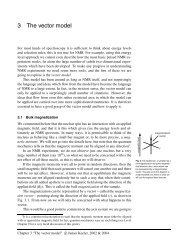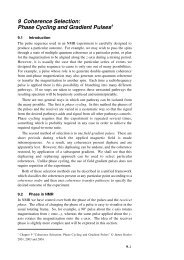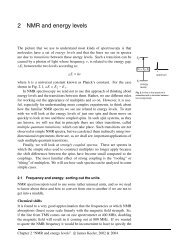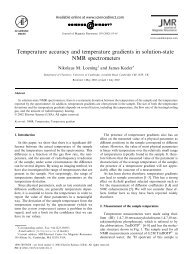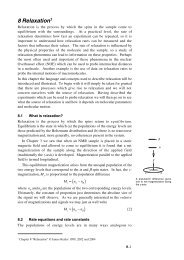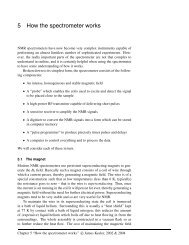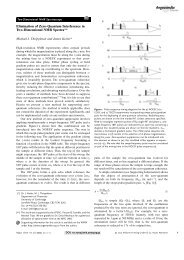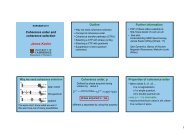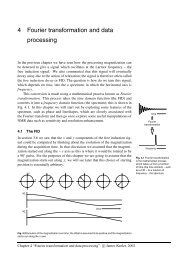Chapter 6: Product operators - The James Keeler Group
Chapter 6: Product operators - The James Keeler Group
Chapter 6: Product operators - The James Keeler Group
- No tags were found...
Create successful ePaper yourself
Turn your PDF publications into a flip-book with our unique Google optimized e-Paper software.
( ) −{ } ( )≡ { − }+ { }exp −iθI I exp iθI cosθ I sin θ – Iy z y z x≡−cosθIz−sinθIxFinally, note that a rotation of an operator about its own axis has no effect e.g. arotation of I xabout x leaves I xunaltered.6.1.5 Shorthand notationTo save writing, the arrow notation is often used. In this, the term Ht is writtenover an arrow which connects the old and new density <strong>operators</strong>. So, forexample, the followingσ( tp)= exp( −iω1tpIx) σ( 0) exp( iω1tpIx)is writtenω1tI pσ( 0)⎯ x→σtFor the case where σ(0) = I z⎯⎯ ( p)1 p xI ⎯⎯⎯ →cos ω t I – sinωt Izω tI6.1.6 Example calculation: spin echo1 p z1 pa b e f90 x delayτ180 x delayτacquire°( ) °( )At a the density operator is –I y. <strong>The</strong> transformation from a to b is freeprecession, for which the Hamiltonian is ΩI z; the delay τ therefore correspondsto a rotation about the z-axis at frequency Ω. In the short-hand notation this isΩτI−I⎯z→σby⎯ ( )To solve this diagram I above is needed with the angle = Ωτ; the "new operator"yis I xΩτIz−I ⎯⎯→− cosΩτI + sin ΩτIyIn words this says that the magnetization precesses from –y towards +x.<strong>The</strong> pulse about x has the Hamiltonian ω 1I x; the pulse therefore correspondsto a rotation about x for a time t psuch that the angle, ω 1t p, is π radians. In theshorthand notationω− cosΩτ I + sin Ωτ I ⎯⎯⎯ 1p tI xyx→σ()e[6.2]Each term on the left is dealt with separately. <strong>The</strong> first term is a rotation of yabout x; the relevant diagram is thus IIω tI1 p x−cosΩτ I ⎯⎯⎯→−cosΩτcosω t I −cosΩτsinωt Iyyx1 p y1 pHowever, the flip angle of the pulse, ω 1t p, is π so the second term on the right iszero and the first term just changes sign (cos π = –1); overall the result isπIx−cosΩτI ⎯⎯→cosΩτIy<strong>The</strong> second term on the left of Eqn. [6.2] is easy to handle as it is unaffected byyz6–5



